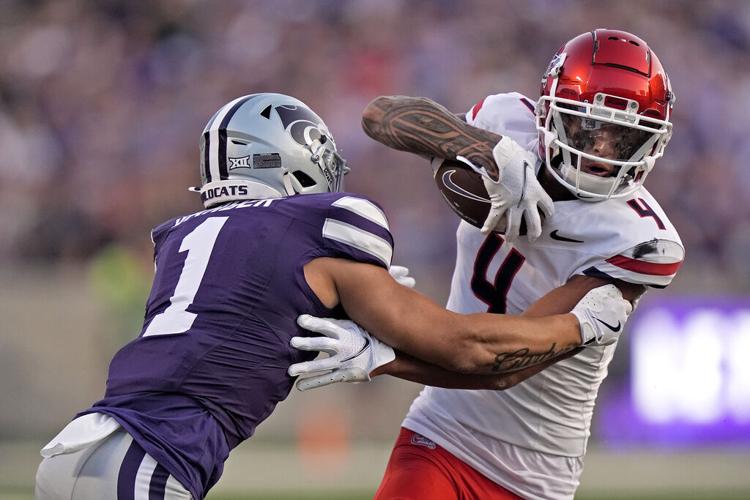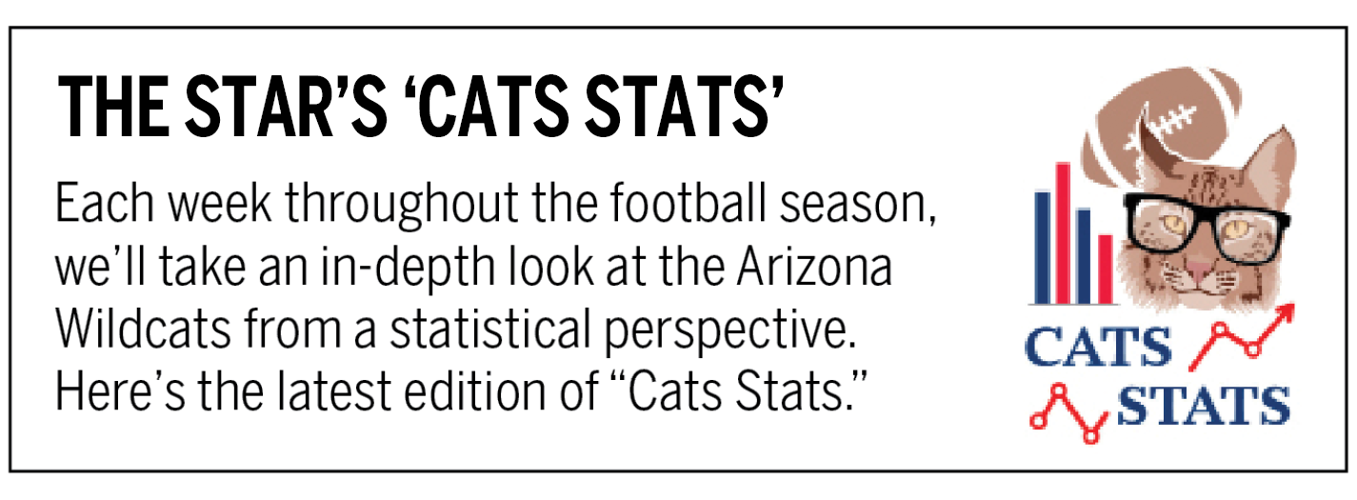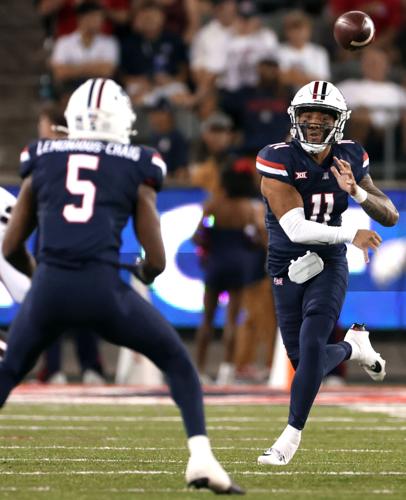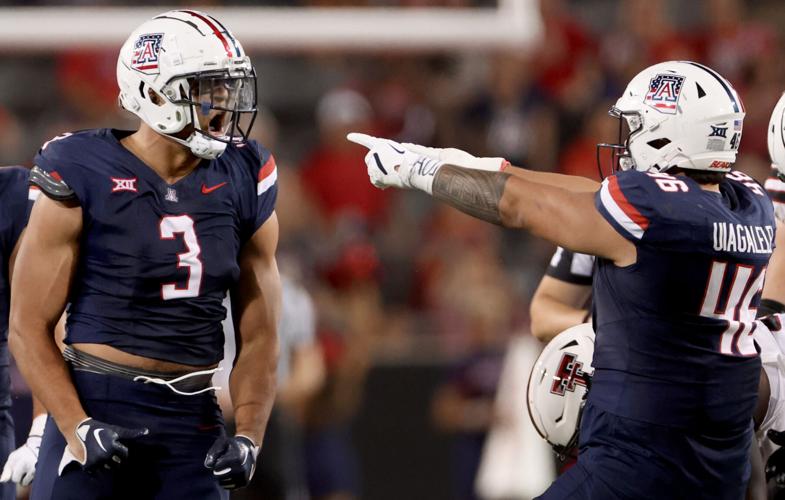Through five games, the Arizona Wildcats are about where we thought they’d be.
They just aren’t who we thought they’d be.
Despite the presence of stars such as Noah Fifita, Tetairoa McMillan and Jonah Savaiinaea, Arizona has struggled on offense since the season opener.
Despite the losses of multiple defensive linemen to graduation or the transfer portal — and multiple defensive backs to injury — the Wildcats have rallied on defense since that Aug. 31 shootout vs. New Mexico.
What are some of the characteristics that define this UA team, which is 3-2, 1-1 in the Big 12 entering Saturday afternoon’s visit to No. 14 BYU (5-0, 2-0)?
We aim to tell that story in this week’s “Cats Stats” through five sets of numbers:
1. Team third-down rate
As a team, Arizona has struggled big time on third downs. The Wildcats have converted 31.7% (20 of 63), a figure that ranks 14th in the 16-team Big 12.

It’s even worse since the opener.
The Cats converted 66.7% (8 of 12) of their third-down attempts vs. the Lobos. In the past four games, Arizona is at 23.5%. Over that span, the Wildcats have 12 third-down conversions — the same number Vanderbilt accumulated in its upset of No. 1 Alabama last week.
The root cause is what’s happening on first and second downs: Arizona isn’t putting itself in a position to succeed on third down.
The New Mexico game is the only one this season in which the Wildcats’ average to gain on third down was less than 6 yards (5.8). It’s been 6.4 yards or higher in every other game, including two in which it was 8.6 (NAU, Utah).
Arizona had the second-highest third-down conversion rate in the Pac-12 last season at 48.8%. The Wildcats clearly miss the likes of Jacob Cowing, Tanner McLachlan, Michael Wiley and Jonah Coleman.

Arizona quarterback Noah Fifita rolls out and finds wide receiver Montana Lemonious-Craig open enough to get him the ball against Texas Tech Saturday Arizona Stadium.
But even some of the players who returned haven’t played at the same level under first-year coach Brent Brennan and his staff.
2. Fifita’s falloff
One of the most remarkable aspects of Fifita’s redshirt-freshman season of 2023 was that he was essentially the same player on third down as any other down. Maybe even better.
Fifita completed 75.9% of his passes on third down last year. He hit at a 72.1% rate on first down and 73.6% on second down.
So far this year, Fifita’s completion percentage has plummeted the deeper the offense gets into a given set of downs. Fifita is a 73.2% passer on first down, 61.3% on second down and 46.5% on third down, per ESPN.com.
The drop-off is particularly stark when it comes to third-and-long situations, which we’ll define as third-and-6-plus for the purpose of this exercise.
In 2023, Fifita connected on 74.5% of his passes in those scenarios. In 2024, that figure is 42.9%.
Again, Arizona has put itself in those situations far too often. The distribution of Fifita’s passing attempts illustrates that.
Last year, Fifita had 83 pass attempts on third down. They included 47 — or 56.6% — when the Wildcats needed to gain 6 or more yards.
This year, Fifita has 43 pass attempts on third down. They include 35 — or 81.4% — when the Wildcats need 6-plus yards.
3. McMillan’s usage
McMillan is on track to become Arizona’s all-time leader in receiving yards. At his current pace, he’d finish the regular season with 89 catches for 1,594 yards and 10 touchdowns — right in line with last year’s numbers (90-1,402-10 in 13 games).
But the Fifita-McMillan connection hasn’t been as efficient.
McMillan has hauled in 62.7% of his team-high 59 pass targets, per Pro Football Focus. That figure was 69.2% last year, including 68.3% in the games Fifita started after taking over for the injured Jayden de Laura.

Arizona wide receiver Tetairoa McMillan, right, tries to get past Kansas State cornerback Keenan Garber during the first half of the teams’ Sept. 13 matchup in Manhattan, Kansas.
What’s changed? For one thing, McMillan’s ADOT — average depth of target — is significantly higher. It’s currently 16.2 yards, per PFF. Last year it was 12.9 yards.
Whether that’s by design or circumstance is unclear. But, generally speaking, the deeper the pass, the harder it is to complete.
McMillan is actually more proficient at snagging downfield passes than his peers with similar ADOTs. Entering Thursday night, only three players with 50 or more targets had ADOTs over 16 yards: McMillan, Duke’s Jordan Moore (16.1) and Stanford’s Elic Ayomanor (16.9). Moore has a 54.5% reception rate, while Ayomanor is at 48%.
Utilizing McMillan more out of the slot could help. McMillan lined up in the slot on 31% of his routes vs. New Mexico, when he had a record-setting performance. Since then, he’s been in the slot just 12.6% of the time. His overall slot usage is 14.9%, down from 23.7% last year, according to PFF.
McMillan has improved markedly after the catch — he averages 8.2 YAC per reception, up from 6.0 in 2023 — so getting him the ball more underneath could be a path to greater efficiency and overall production.
4. Pressure package
Brennan and his staff had to scramble to fill roster holes after taking over in mid-January — six weeks after the transfer portal first opened.
They acquired two impact defenders in ends Tre Smith and Chase Kennedy.
Smith, who came to Arizona from San Jose State, was tied for 10th nationally with 22 quarterback pressures entering Thursday night. He’s on pace for 53 pressures in 12 games — which would be the most by a Wildcat since PFF started charting college games in 2014.
Scooby Wright III had 47 pressures that year. Reggie Gilbert had 40 the following season. No UA defender has reached the 40 mark since.
Not only is Smith on track do to it, but Kennedy is as well. The transfer from Utah has 18 pressures, putting him on pace for 43.

Arizona defensive lineman Tre Smith, left, and fellow lineman Ta’ita’i Uiagalelei celebrate their sack against Texas Tech in the third quarter of the UA’s Big 12 home opener on Oct. 5 at Arizona Stadium.
If Smith keeps up his current rate, he’ll eclipse his total from last season — 47 in 13 games. Of the nine players ahead of him this year, four have played in six games. (Shoutout to Ohio’s Bradley Weaver, who ranks seventh with 24 pressures despite playing in only four games.)
Kennedy has been a more effective pass rusher on a per-snap basis. He ranks seventh in the Big 12 with a 14.4% win rate (minimum 100 pass-rush snaps). Smith is eighth at 14.1%.
Kennedy is tied for eighth in win rate (20%) in what PFF defines as “true pass sets” (excluding screens, play-action and rollouts). Smith is 11th at 19%.
5. Cornering the market
It has been difficult to complete passes against Arizona’s cornerbacks this season.
The Wildcats’ top three corners — Tacario Davis, Emmanuel Karnley and Marquis Groves-Killebrew — each have allowed a reception rate of less than 50%.
Karnley, who has started the past two games, leads the way at 39.1% (9 of 23). Groves-Killebrew is next at 42.9% (6 of 14). Davis is at 45.5% (15 of 33). PFF has charged the trio with only one touchdown allowed (Karnley vs. Utah).

Arizona cornerback Tacario Davis, right, nearly intercepts a pass during the Wildcats’ win at Utah on Sept. 28 in Salt Lake City. Davis and teammate Emmanuel Karnley, left, have held pass catchers to a sub-50% reception rate.
All three rank in the top 15 among Big 12 cornerbacks in reception percentage against. The only other team with three corners in the top 15 is Iowa State. Only two other teams have two (Baylor, Utah).
PFF also calculates what the NFL passer rating would be against specific defenders. The numbers posted by Arizona’s cornerbacks so far would get any quarterback benched.
Groves-Killebrew has an NFL passer rating against of 61.0. Karnley is at 69.1. Davis is at 70.4.
The lowest rating among the top 31 qualifying quarterbacks in the NFL this season is 71.4.








